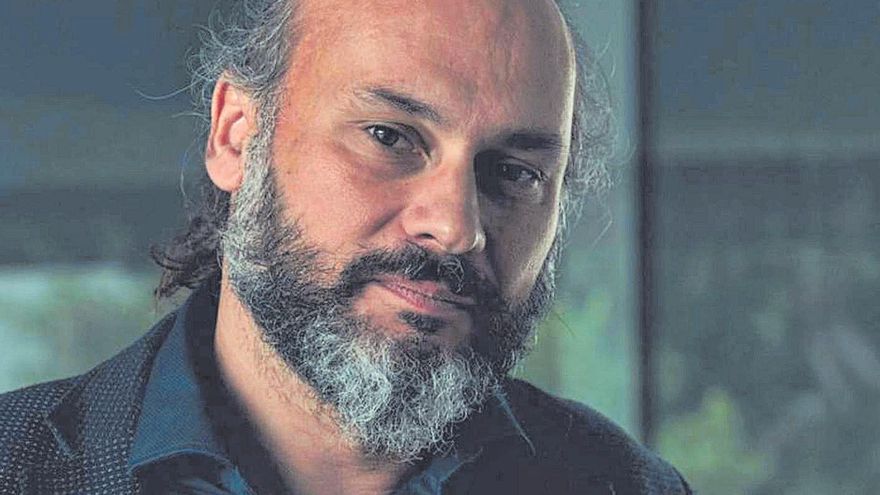
The previous life brings together the most recent poetry of Isidro Hernández (Tenerife, 1975). Known for books such as Trasluz (2000), El árbol blanco (2002) or El ciego del alba (2008), which received the VII Emilio Prados International Poetry Prize, and which was followed by the volume of notes El aprendiz, Isidro Hernández was a professor at the University of Western Brittany between 2001 and 2003 and currently works as chief curator of the TEA Collection (Tenerife Espacio de las Artes). His works on Oscar Dominguez and other Canarian artists and writers, especially from the historical avant-garde.
This new book is made up of three sections: the one that gives the book its title, Camino hacia los palmitos, and El encanto de acusico. The poems present a concept and a vocabulary that remind us of the irrationality of avant-garde, although without unnecessary excesses. The three sections constitute different aspects –or rather intentions– of the poetic vision, but they are not far from each other. The first, La vida anterior, seems to allude to a space before time, the life of the immense nature, and for this purpose, the past is constantly used through the use of verbs in this time and, furthermore, with frequent references to childhood, for which time is a dimension still unknown. Certain very explicit localisms already appear here with respect to a very specific and unequivocal space (“guanche”, “tabaibas”, “palmas”, “cernícalos”), and even with unmistakable place names (Anosma, Cabezo del Tejo). In Camino hacia los palmitos, the second section, the metaphysical tone is accentuated with somewhat more symbolic and essentialist references to nature, which reach the question of matter itself and the animal world (“mustard-colored dragonflies”, “the victory animal over men”). In the third section, El encanto de pincushion, we can see that the spatial references are maintained, as well as the metaphysical and reflective tone of the poems in the two previous sections. We observe, however, a greater presence of the second person (“you wonder”, “you don’t imagine”, “you told me”, etc.), as if the author personified the recipient of the poem, unfolding himself; it is obvious that, in many cases, the poetic voice speaks to itself, a very frequent resource in lyrical expression.
José Corredor-Matheos rightly affirms, in the epilogue to the book, that the spatial references, in these poems, “transcend immediate reality.” It is not strictly a question of landscape (which is, let us not forget, a cultural concept), but of a kind of geology and even a poetic geognosy, through which the human being manages to intuit what the Venezuelan poet Eugenio Montejo called the «earthiness», the terrestrial condition of existence, strongly linked to nature, and to a concrete nature. It is the nature through which the poet travels and where he wonders about human existence in time. In a note on the back cover, Andrés Sánchez Robayna clearly points it out: it is a nature «naked, essential, prior to time, […] that world that is at the root of all existence, and whose heartbeat we must recover ». Melchor López, for his part, points out that we are dealing with a “mythical-geological poetry, because it not only knows the exterior views of the landscape but also the interior of the Earth from the beginning.”
In recent statements, Isidro Hernández stressed that, in this book, “the poem is allowed to pass through nature in the manner of an umbilical cord that at times returns us to the land of origin.” Canarian poets, in fact, have been very sensitive to the “earth” in its spatial dimension, perhaps because of the insular condition itself. But from the concrete earth they pass to a “transcendence”, to supernature, that is, to a metaphysical dimension. In the aforementioned statements, we are especially interested in a few words from the author in relation to this matter. He goes so far as to state that in the generations of writers and painters who have worked for Canary Islands, many have worked in a metaphysical tradition, which gives enormous strength to poetry, whether it is the pure exaltation of nature, or the elegy for the erosion of the environment, or as a sphere of living, to the extent that the poet feels and he thinks of nature in its ontological condition, based on the relationship between physical exteriority and spiritual interiority. The author attaches great importance to this experience of natural space today, and even maintains that it is not really possible to consider this importance or this influence without first assessing the effect exerted in previous times, on other generations of Canarian writers or artists: ravines, seas, cliffs, rocks, etc., to which Hernández now adds palm trees, hawks, tabaibas and “dragons” (his way of alluding to dragon trees). Other times, as is common in the Canarian tradition, they speak of water and the sea, of the shores, the beaches and the sands, without lack of light, a light in time, the timeless light of childhood; a light of “nakedness” or “madness”, sometimes with classical or mythological references (“Orion”, “Saturn”, “cyclops”).
La vida anterior is a book that has among its merits delving into a tradition, that of Canarian poetry, full of symbols and the will to transcendence. A book that, in addition to inserting itself into modernity, continues the insular tradition (at least since the modernists, with more than one precedent) of exploration in nature, but that it does so with the means of poetic modernity. Brief book but full of meaning to reconnect with the homeland or to learn about the natural reality of the archipelago from a peculiar and demanding perspective. A book, in short, that intends, and manages, to carry forward a tradition.
















